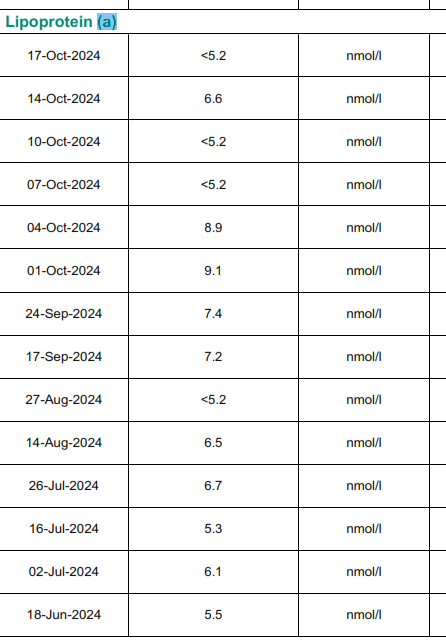KiwiGuy
#169
My lp(a) levels are 1250 mg/L (>300 considered High). I’ve just started Leqvio (1st shot today). In the absence of a method to meaningfully decrease lp(a), my approach will be to address the wider CVD risk. I am having an CT Angiogram soon to check for plaques and am aggressively managing other lipid levels down. Also taking Nattokinase.
4 Likes
I don’t know why, but my lp(a) tends to be quite low. I would be happy to try to work out why this is. Sadly I don’t have any values from before I started biohacking.

The values of 9.1 and 8.9 seem to be as a result of my second high dose of rapamycin.
I don’t take dut or fin although I have AGA. PSA tends to be low.
Converting to mg/dL divide by 2.15 converting to mg/L divide by 0.215 - although as particle size varies that is not an ideal conversion system.
Lp(a) differs from other lipoproteins due to its unique structure. Each Lp(a) particle is made up of one molecule of LDL (“bad cholesterol”) linked to a distinctive protein called apolipoprotein(a), which varies greatly in size between individuals. This structural variability results in a wide range of molecular weights for Lp(a) particles, making it challenging to standardize a conversion factor.
What’s slightly odd about the movements when rapa was high in serum is that when you look at LDL-C the ratio between LDL-C and Lp(a) seems to vary

1 Like
nikney
#173
It is probably an RNA-based drug. It is a revolutionary drug that reduces lipoproteina levels by an incredible 90 percent by suppressing the gene region that synthesizes lipoproeina. Eli Lilly may have developed this drug by using artificial intelligence. If we consider that the biggest cause of death in the world is vascular diseases due to atherosclerosis, it will create an incredible increase in the average human life span.
Neo
#174
Probably largely genetic I’d assume as this is very genetically driven
This is where I suffer from not having a baseline for this biomarker. I have been doing various biohackingy sort of things since about 2019 although initially it was a scattergun approach and only started doing blood tests in 2021. (and only 1 in 2021 and it was not broad enough).
Neo
#176
Have you done holistic DNA testing - you could see if you have the “right” version of LPA, etc
adssx
#177
Independence of Lipoprotein(a) and Low-DensityLipoprotein Cholesterol–Mediated CardiovascularRisk: A Participant-Level Meta-Analysis 2024
These findings demonstrate the independent and additive nature of Lp(a) and LDL-C levels for ASCVD risk, and that LDL-C lowering does not fully offset Lp(a)-mediated risk.
3 Likes
Davin8r
#178
Which makes sense if a major mechanism of Lp(a)'s increased risk is mediated by excess platelet adhesion/thrombosis. Hoping my plavix continues to do its job!
1 Like
I find I have LPA data, but cannot tell what that means in terms of whether or not it is the right version. Is there a good online way of getting this from the raw data?
Neo
#180
Some of those platform are discussed here I think, and if not you can ask the people who know about it on that thread:
drfawn
#181
Are they still accepting people with high LP(a) into their trials? If so, how do I sign up?
Neo
#183
2 Likes
This tells me that you need to lower Lp(a) in addition to LDL. Low LDL doesn’t reduce risk to 0 by itself, but it still helps. I guess I need an Lp(a) test too to really find out where I stand.
An Lp(a) greater than 50 is considered the highest risk though.
1 Like
adssx
#185
Posted just above  New Lp(a) lowering drug - #177 by adssx
New Lp(a) lowering drug - #177 by adssx
And yeah, it’s bad news. It probably means that people with high Lp(a) should try to reach their LDL-C target without a statin as statins can increase Lp(a) even more:
Sam Tsimikas’ answer to the suggestion to look at people with LDL-C ~ 30 mg/dL:
Lp(a)HORIZON (pelacarsen vs placebo) will read out in early 2025. It’s phase 3 so if positive, approval is possible in 2026? Same for obicetrapib. They both lower Lp(a) by about 60%. So the problem of elevated Lp(a) might be “solved” in a couple of years for people with Lp(a) around 100 mg/dL (to go below 50). Those with Lp(a) > 100 mg/dL might have to wait for olpasiran (phase 3 results in 2027) and lepodisaran (phase 3 results in 2029) that crush Lp(a) almost to zero.
6 Likes
adssx
#186
EICOSAPENTAENOIC ACID INHIBITS LIPOPROTEIN(A) OXIDATION DUE TO SCAVENGING MECHANISMS IN VITRO 2024
Elevated Lp(a) levels are an independent and causal risk factor for cardiovascular disease with limited treatments currently available. Oxidized Lp(a) stimulates foam cell formation, endothelial dysfunction and inflammation.
Lp(a)-enriched ApoB particles underwent time-dependent oxidation, reaching a peak oxidation value after 2 hours (27-fold, 0.45 ± 0.07 vs 12.60 ± 0.24, p <0.001) that were sustained through 4 hours. EPA significantly inhibited Lp(a) oxidation in a time-dependent manner through 3 hours. After 3 hours, EPA inhibited oxidation by 31% (8.04 ± 0.79 μM, p <0.001) while EA had no activity.
EPA inhibited oxidation of Lp(a)-enriched plasma in a time-dependent fashion consistent with a free radical scavenging mechanism. The potent antioxidant actions of EPA may contribute to reduced CV events in REDUCE-IT, including those subjects with elevated Lp(a).
Is the above clinically relevant?
5 Likes
Ulf
#187
I tried gemfibrozil and it did not lower my high lp(a).
Am researching the merits of the anecdotal reports of amla + lysine and Vit C + collagen reducing lp(a).
4 Likes
Ulf
#188
In vitro studies rarely prove to be clinically relevant.
FWIW, my big intake of EPA from >1 kilo of fat fish per week has done nothing for my lp(a).
4 Likes